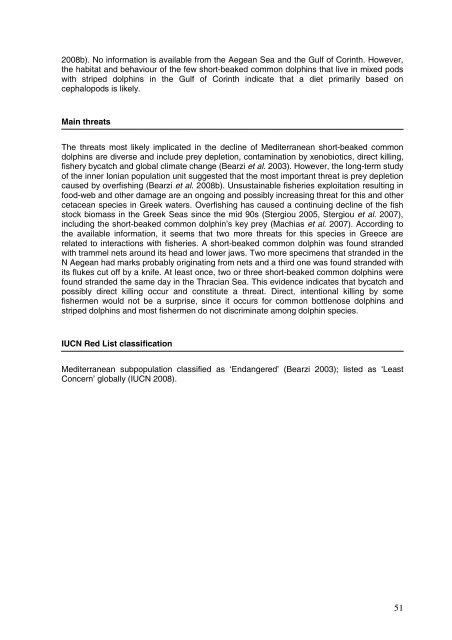Cetaceans in Greece: Present status of knowledge
Cetaceans in Greece: Present status of knowledge
Cetaceans in Greece: Present status of knowledge
You also want an ePaper? Increase the reach of your titles
YUMPU automatically turns print PDFs into web optimized ePapers that Google loves.
2008b). No <strong>in</strong>formation is available from the Aegean Sea and the Gulf <strong>of</strong> Cor<strong>in</strong>th. However,<br />
the habitat and behaviour <strong>of</strong> the few short-beaked common dolph<strong>in</strong>s that live <strong>in</strong> mixed pods<br />
with striped dolph<strong>in</strong>s <strong>in</strong> the Gulf <strong>of</strong> Cor<strong>in</strong>th <strong>in</strong>dicate that a diet primarily based on<br />
cephalopods is likely.<br />
Ma<strong>in</strong> threats<br />
The threats most likely implicated <strong>in</strong> the decl<strong>in</strong>e <strong>of</strong> Mediterranean short-beaked common<br />
dolph<strong>in</strong>s are diverse and <strong>in</strong>clude prey depletion, contam<strong>in</strong>ation by xenobiotics, direct kill<strong>in</strong>g,<br />
fishery bycatch and global climate change (Bearzi et al. 2003). However, the long-term study<br />
<strong>of</strong> the <strong>in</strong>ner Ionian population unit suggested that the most important threat is prey depletion<br />
caused by overfish<strong>in</strong>g (Bearzi et al. 2008b). Unsusta<strong>in</strong>able fisheries exploitation result<strong>in</strong>g <strong>in</strong><br />
food-web and other damage are an ongo<strong>in</strong>g and possibly <strong>in</strong>creas<strong>in</strong>g threat for this and other<br />
cetacean species <strong>in</strong> Greek waters. Overfish<strong>in</strong>g has caused a cont<strong>in</strong>u<strong>in</strong>g decl<strong>in</strong>e <strong>of</strong> the fish<br />
stock biomass <strong>in</strong> the Greek Seas s<strong>in</strong>ce the mid 90s (Stergiou 2005, Stergiou et al. 2007),<br />
<strong>in</strong>clud<strong>in</strong>g the short-beaked common dolph<strong>in</strong>’s key prey (Machias et al. 2007). Accord<strong>in</strong>g to<br />
the available <strong>in</strong>formation, it seems that two more threats for this species <strong>in</strong> <strong>Greece</strong> are<br />
related to <strong>in</strong>teractions with fisheries. A short-beaked common dolph<strong>in</strong> was found stranded<br />
with trammel nets around its head and lower jaws. Two more specimens that stranded <strong>in</strong> the<br />
N Aegean had marks probably orig<strong>in</strong>at<strong>in</strong>g from nets and a third one was found stranded with<br />
its flukes cut <strong>of</strong>f by a knife. At least once, two or three short-beaked common dolph<strong>in</strong>s were<br />
found stranded the same day <strong>in</strong> the Thracian Sea. This evidence <strong>in</strong>dicates that bycatch and<br />
possibly direct kill<strong>in</strong>g occur and constitute a threat. Direct, <strong>in</strong>tentional kill<strong>in</strong>g by some<br />
fishermen would not be a surprise, s<strong>in</strong>ce it occurs for common bottlenose dolph<strong>in</strong>s and<br />
striped dolph<strong>in</strong>s and most fishermen do not discrim<strong>in</strong>ate among dolph<strong>in</strong> species.<br />
IUCN Red List classification<br />
Mediterranean subpopulation classified as ‘Endangered’ (Bearzi 2003); listed as ‘Least<br />
Concern’ globally (IUCN 2008).<br />
51


